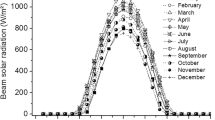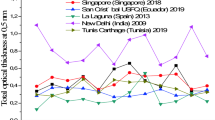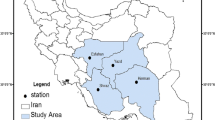Abstract
This paper constructs probability density distributions of direct normal, diffuse horizontal, and global horizontal irradiance for 1-min clearness indexes kb, kd, and kt, respectively. Previous studies on the clearness index, conditioned to the optical air mass, are analyzed and distributions of these three indexes, using data from two solarimetric stations in Brazil, are presented. The pattern found in probability density distributions, in general, matches the patterns found in the literature. The 50th percentile (P50) of kb values from Sao Paulo city (a location with high levels of pollution) is 0.22, and from the countryside region of the state of Sao Paulo (a location with expected low levels of pollution), it is 0.55. Regarding kt values, P50 is 0.57 and 0.72 for these two regions, respectively. We conclude that different atmospheric conditions result in a different dependence relation between probability density distribution and air mass increases. These conditions include not only cloud formation, but also pollution levels and the influence of relative humidity. These specific results endorse the need for local radiation measurements to the characterization of few-minute average of transmittance indexes.







Similar content being viewed by others
References
Andrade MF, Kumar P, Freitas ED, Ynoue RY, Martins J, Martins LD, Nogueira T, Perez-Martinez P, Miranda RM, Albuquerque T, Gonçalves FLT, Oyama B, Zhang Y (2017) Air quality in the megacity of Sao Paulo: evolution over the last 30 years and future perspectives. Atmos Environ 159:66–82
Assunção HF, Escobedo JF, Oliveira AP (2003) Modelling frequency distributions of 5 minute-averaged solar radiation indexes using Beta probability functions. Theor Appl Climatol 75:213–224
Bendt P (1981) The frequency distribution of daily insolation values. Solar Energy 27:1–19
Brazil (2018a) Sao Paulo. Available in: https://cidades.ibge.gov.br/brasil/sp/sao-paulo/panorama. Accessed Apr 2018
Brazil (2018b) Rosana. Available in: https://cidades.ibge.gov.br/brasil/sp/rosana/panorama. Accessed Apr 2018
Brazil (2018c) Programa Queimadas. Available in: https://queimadas.dgi.inpe.br/queimadas/portal. Accessed Apr 2018
Carvalho VSB, Freitas ED, Martins LD, Martins JA, Mazzoli CR, Andrade MF (2015) Air quality status and trends over the Metropolitan Area of São Paulo, Brazil as a result of emission control policies. Environ Sci Pol 47:68–79
CESP (2019) [Energetic Company of Sao Paulo State]. Usina Hidrelétrica Eng Sérgio Motta. Available in: http://www.cesp.com.br/portalCesp/portal.nsf/V03.02/Empresa_UsinaPorto?OpenDocument&Menu=5%20-%20menu_lateral@@002_004_003. Accessed Apr 2019
Davies JA, McKay DC (1982) Estimating solar irradiance and components. Sol Energy 29(1):55–64
Gueymard CA, Ruiz-Arias JA (2016) Extensive worldwide validation and climate sensitivity analysis of direct irradiance predictions from 1-min global irradiance. Sol Energy, v 128:1–30
INPE. [Instituto Nacional de Pesquisas Espaciais] (2017) Sistema de Organização Nacional de Dados Ambientais: validação dos dados. http://sonda.ccst.inpe.br/infos/validacao.html. Accessed Jan 2019
Iqbal M (1983) An introduction to solar radiation. Academic, Toronto 390pp
Journeé M, Bertrand C (2011) Quality control of solar radiation data within the RMIB solar measurements network. Sol Energy 85:72–86
Jurado M, Caridad JM, Rauiz V (1995) Statistical distribution of the clearness index with radiation data integrated over five minutes intervals. Sol Energy, v 40(6):469–473
Liu HYB, Jordan CR (1960) The interrelationship and characteristic distribution of direct, diffuse and total solar radiation. Sol Energy 4:1–19
Moura LM, Martins FR, Assireu AT (2016) Variability of cloudness in São Paulo city. Rev Ambient Água 11(4):903–914 (in Portuguese)
Myhre G, Shindell D, Bréon F-M, Collins W, Fuglestvedt J, Huang J, Koch D, Lamarque J-F, Lee D, Mendoza B, Nakajima T, Robock A, Stephens G, Takemura T, Zhang H (2013) Anthropogenic and natural radiative forcing. In: Stocker TF, Qin D, Plattner G-K, Tignor M, Allen SK, Boschung J, Nauels A, Xia Y, Bex V, Midgley PM (eds) Climate change 2013: the physical science basis. Contribution of working group I to the fifth assessment report of the intergovernmental panel on climate change. Cambridge University Press, Cambridge
NREL [National Renewable Energy Laboratory] (1993) User’s manual for SERI QC software, assessing the quality of solar radiation data. Report No. NREL-TP-463-5608. National Renewable Energy Laboratory, Golden
Pacheco MT, Parmigiani MMM, Andrade MF, Morawska L, Kumar P (2017) A review of emissions and concentrations of particulate matter in the three major metropolitan areas of Brazil. J Transp Health, v 4:53–72
Perez R, Hemker K Jr (2011) Solar forecasting characterization. Report on Contract No. AGJ-1-11854-01. Alliance for Sustainable Energy (National Renewable Energy laboratory, Golden
Perez R, Hoff TE (2012a) In: Kleissl J (ed) Solar resource variability. Book chapter for solar energy forecasting and resource assessment. Elsevier, Waltham
Perez R, Hoff TE (2012b) In: Kleissl J (ed) SolarAnywhere Forecasting. Book chapter for solar energy forecasting and resource assessment. Elsevier, Waltham
Perez R, Kivalov S, Schlemmer J, Hemker K Jr, Hoff TE (2012) Short-term irradiance variability: preliminary estimation of station pair correlation as a function of distance. Sol Energy 86(8):2170–2176
Rosas J (2018) Clouds and their effects on solar radiation at São Paulo, Thesis (Master). Instituto de Astronomia, Geofísica e Ciências Atmosféricas, Universidade de São Paulo, São Paulo (in Portuguese)
Schmithüsen, H., Sieger, R., König-Langlo, G. (2012) BSRN Toolbox V2.0 - a tool to create quality checked output files from BSRN datasets and station-to-archive files. Alfred Wegener Institute, Helmholtz Center for Polar and Marine Research, Bremerhaven, PANGAEA. https://doi.pangaea.de/10.1594/PANGAEA.774827?format=html. Accessed May 2018
Shayani RA (2006) Medição do Rendimento Global de um Sistema Fotovoltaico Isolado Utilizando Módulos de 32 Células. 205p. Master Thesis – University of Brasilia, Brasília
Skartveit A, Olseth JA (1992) The probability density and autocorrelation of short-term global and beam irradiance. Sol Energy 49(6):477–487
Suehrcke H (1994) The effect of time errors on the accuracy of solar radiation measurements. Sol Energy 53(4):353–357
Suehrcke H, McCormick PG (1988) The frequency distribution of instantaneous insolation values. Sol Energy 40(5):413–422
Tovar M, Olmo FJ, Batlles FJ, Alados-Arboledas L (1998) One-minute global irradiance probability density distributions conditioned to the optical air mass. Sol Energy 62(6):387–393
Tovar M, Olmo FJ, Batlles FJ, Alados-Arboledas L (1999) One-minute kb and kd probability density distributions conditioned to the optical air mass. Sol Energy 65(5):297–304
WMO [World Meteorological Organization] (2012) Guide to Meteorological Instruments and Methods of Observation, Ed. de 2008, updated in 2010. Publications Board, Chairperson, Geneva
Vignola F, Michalsky J, Stoffel T (2012) Solar and infrared radiation measurements. Taylor & Francis Group, Boca Raton
Acknowledgments
To CAPES and CNPQ, for the scholarship; to CESP, for funding the P&D ANEEL PD-0061-0043/2014, enabling the accomplishment of this article; to Flavius Ageu Chitto dos Reis for proofreading and language editing. We would also like to thank the team of researchers and collaborators who directly or indirectly influenced the P&D ANEEL and the anonymous reviewer for his highly valuable comments.
Author information
Authors and Affiliations
Corresponding author
Additional information
Publisher’s note
Springer Nature remains neutral with regard to jurisdictional claims in published maps and institutional affiliations.
Rights and permissions
About this article
Cite this article
Relva, S.G., Gimenes, A.L.V., Udaeta, M.E.M. et al. Transmittance index characterization at two solar measurement stations in Brazil. Theor Appl Climatol 139, 205–219 (2020). https://doi.org/10.1007/s00704-019-02941-6
Received:
Accepted:
Published:
Issue Date:
DOI: https://doi.org/10.1007/s00704-019-02941-6




